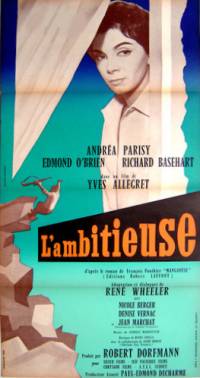
The Restless and the Damned
The Restless and the Damned (also known as L'Ambitieuse) is a 1959 French-Australian film co produced by Lee Robinson. It was shot on location in Tahiti and the Tuamotu Islands. There are French and English-language versions.[4]
The Restless and the Damned
novel Manganese by François Ponthier
Carl Kayser
Henri Persin
Louis Stein
Giles Bonneau
Albert Jurgenson
Australian Television Enterprises (Australia)
15 October 1959 (France)
December 1964 (Canada)[1]
98 minutes
Australia
English
French
£600,000[2]
767,540 admissions (France)[3]
The film's financial failure marked the end of Robinson's involvement in the film industry in the 1950s. It is also known as The Ambitious One, The Dispossessed and The Climbers.[5]
Synopsis[edit]
In Tahiti, an ambitious woman, Dominique, promotes the fortunes of her simple husband, George, by extracting money from George's family to finance his operations and encouraging him to doublecross his boss on phosphate mine in Tahiti. She also seduces George's boss, while George takes over some mine deeds that the boss has allowed to lapse.
George and Dominque become rich. However, when George decides to leave Dominique for another woman, Claire, she tries to kill him.[6]
Production[edit]
The movie was the last of three co-productions Australians Lee Robinson and Chips Rafferty did with French companies in the late 1950s, after Walk into Paradise and The Stowaway. The films were shot in English and French versions with a combined Australian and French crew. While Walk into Paradise was set in Papua New Guinea, then an Australian territory, and starred an Australian, Chips Rafferty, both The Stowaway and The Restless and the Damned were essentially French stories, albeit with international casts.[2]
Rafferty and Robinson contributed £40,000 of the film's budget, coming from hire of studio facilities to two films shot in Tahiti and their involvement in several episodes of the US documentary series, High Adventure.[7] Robinson said they did not have the funds to be a full partner in the film but they contributed 30% of the costs while the French partners contributed 70%. "It's a major international film, with American stars in it, and French stars," said Robinson. "Andrea Parisy was a French star and the French ended up having to carry the whole of the load, which they could afford to do."[2]
Robinson said "Dorfmann is one of the most brilliant producers in Europe. And if we could have maintained some working relationship with Dorfmann, we might have got somewhere. He's a very talented producer."[2]
Edmond O'Brien later said his net from the film "will obviously exceed the $150,000 or $200,000 most actors can hope to realize from a Hollywood salary." Producer Dorfman claimed "The revenue a European production can get without a Hollywood star is, at best, limited. On the other hand many actors such as Mr O'Brien and Robert Ryan are top attractions in the European and Oriental countries where we obtain our major income." Dorfman said they signed O'Brien on the strength of his performance in The Girl Can't Help It adding "throughout Europe it was considered a comedy of importance and established O'Brien as a major attraction there - much more, for instance than his Academy Award role in The Barefoot Contessa."[8]
The film was shot in late 1958. Originally Lee Robinson was to direct the English-language version, which had happened on the first two films, but after a few days Yves Allégret directed both.[9]
Basehart arrived in Paris in February 1959 to shoot studio scenes.[10]